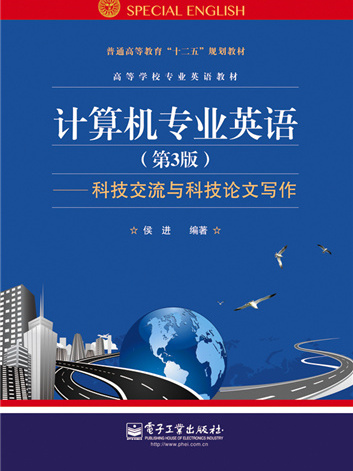《計算機專業英語(第3版)——科技交流與科技論文寫作》是2014年3月電子工業出版社出版的圖書,作者是侯進。
基本介紹
- 書名:計算機專業英語(第3版)——科技交流與科技論文寫作
- 作者:侯進
- ISBN:9787121225161
- 頁數:248頁
- 定價:36元
- 出版社:電子工業出版社
- 出版時間:2014年3月
- 開本:16開
內容簡介,圖書目錄,
內容簡介
本書結合作者長期在國外使用英語從事研究的經驗,旨在培養讀者把英語作為工作語言,提高讀者專業英語的運用能力。本書分為3部分,主要內容包括:如何用英語做研究報告,英文科技論文和畢業論文的寫作規範及技巧,如何參加國際會議和用英文演講,如何向國際期刊投稿,如何檢索文獻及怎樣選擇研究課題等;介紹計算機專業前沿課題動向,以及學術研究新成果、新方法、新技術,並附相關學術論文;提供一些長期在國外的專家學者的建議和經驗,幫助讀者逐步提高獨立創新工作的能力。本書每節後附辭彙表、習題和相關附錄,並提供電子課件。
圖書目錄
目 錄
PART 1 METHODOLOGIES & SKILLS
Chapter 1 How to Make a Research Presentation 2
1.1 When Do We Need to Make a Presentation? 2
1.2 The Structure of a Presentation 2
1.3 Sample 2
1.4 Pay Attention 5
1.5 Practical Tricks 6
Exercises 6
Appendix I 7
Appendix II 7
Appendix III 7
Chapter 2 How to Write a Scientific Paper 9
2.1 The Clear Structure of a Scientific Paper 9
2.2 Abstract 9
2.3 Introduction and Conclusion 10
2.4 Main Body of a Paper 11
2.5 Reference 12
2.6 Useful Tricks 12
Exercises 13
Appendix I 13
Appendix II 16
Chapter 3 How to Write a Ph.D. /Master Thesis 23
3.1 The Common Structure of a Thesis 23
3.2 Cover Page 23
3.3 Abstract 24
3.4 Acknowledgements 25
3.5 Table of Contents and List of Figures/Tables 25
3.6 Chapters 25
3.7 List of Publications 25
3.8 Bibliography 25
Exercises 25
Appendix I 26
Appendix II 30
Chapter 4 How to Attend an International Conference 31
4.1 Purpose 31
4.2 Call for Paper (CFP) 31
4.3 Write and Submit a Paper to an International Conference 36
4.4 Notification of Acceptance 36
4.5 Apply for a Visa 36
4.6 Present a Paper 37
Exercises 37
Appendix I 37
Appendix II 43
Chapter 5 How to Submit a Paper to a Top Journal/Transaction 44
5.1 Prepare and Submit 44
5.2 Submission Confirmation 44
5.3 Paper Decision 45
5.4 Reviewer’s Comments 47
5.5 Revise and Submit the Final Paper 51
Exercises 51
Appendix I 52
Appendix II 56
Chapter 6 How to Search for Information on the Internet 59
6.1 Search Sites 59
6.2 Full Text Access 59
6.3 Database Index 60
Exercises 61
Appendix I 61
Appendix II 61
Chapter 7 How to Select a Research Subject 63
7.1 Follow Your Interest 63
7.2 Attend to New Theory or Technology 63
7.3 Think Independently 63
7.4 Search Literature Extensively 63
7.5 Interdisciplinary Research Provides New Opportunity 64
Exercises 64
Appendix 64
PART 2 NEW TECHNOLOGIES
Chapter 8 Geographic Information System (GIS) 68
8.1 What is GIS? 68
8.2 GIS Technology 68
8.3 Feature of GIS 69
8.4 The Future of GIS 70
Exercises 71
Appendix 71
Chapter 9 Communication by Avatars 72
9.1 What is Avatar? 72
9.2 Purpose 72
9.3 Technology 73
9.4 Challenges and Emerging Trends 76
9.5 Summary 77
Exercises 78
Appendix 78
Chapter 10 Natural Language Processing 79
10.1 What is Natural Language Processing (NLP)? 79
10.2 Difficulties 79
10.3 Major Tasks in NLP 80
10.4 Evaluation of Natural Language Processing 81
Exercises 82
Appendix 82
Chapter 11 Content-based Image Retrieval 83
11.1 What is Content-based Image Retrieval? 83
11.2 Content Comparison Techniques 83
11.3 Semantic Image Retrieval 84
11.4 New Media 85
11.5 Future Directions 85
Exercises 88
Appendix 88
Chapter 12 Molecular Dynamics Simulation 90
12.1 Molecular Dynamics (MD) 90
12.2 Areas of Application 90
12.3 Molecular Dynamics Algorithm-Parallel Computing 91
12.4 Major Software for MD Simulations 92
12.5 The Aims of Molecular Dynamics Simulation 93
Exercises 93
Appendix 94
Chapter 13 OpenGL Technology 95
13.1 What is OpenGL (Open Graphics Library) Technology? 95
13.2 Design 95
13.3 OpenGL 3.0 96
Exercises 97
Appendix 98
Chapter 14 Distance Learning 99
14.1 What is Distance Learning? 99
14.2 Electronic Learning 99
14.3 Virtual Learning Environment (VLE) 100
Exercises 100
Appendix 101
Chapter 15 Semantic Web 102
15.1 Definition 102
15.2 Purpose 102
15.3 Skeptical Reactions 103
15.4 Components 103
Exercises 104
Appendix 104
Chapter 16 Ontology 117
16.1 Definition 117
16.2 Components of Ontologies 118
16.3 Elements 118
16.4 Ontology Languages 120
Exercises 121
Appendix 121
PART 3 ADVICES & EXAMPLES
Chapter 17 Ten Rules for a Successful Presentation 123
17.1 Use the Same Language of the Listener 123
17.2 Keep SMART 123
17.3 Plan and Schedule Your Presentation 124
17.4 Keep It Short and Simple (KISS) 124
17.5 Make Your Audience Active Instead of Reactive 124
17.6 Structure Your Thinking and Make It Visible 125
17.7 Don’t Let the Listener Lose His Way 125
17.8 Use Stimulus 126
17.9 Use Pictures 126
17.10 Make the Start Attractive and the End Memorable 126
Chapter 18 Promoting International Science and Technology Collaboration 127
18.1 Introduction 127
18.2 Studying in Japan as a Foreign Student 130
18.3 Research Culture in Japan 131
18.4 Japanese Research Style 131
18.5 Establishing a Joint Research During a Visiting Stay in Switzerland 132
18.6 Practical Information on Conducting Research in Japan 134
18.7 Practical Information on Studying in Japan 135
附錄A 參考譯文 137
附錄B 參考論文 189
附錄C 論文寫作自查表 206
附錄D 學位論文寫作自查表 208
附錄E 總單詞表 209
附錄F Suggested Answers for Discussion 230
參考文獻 237

